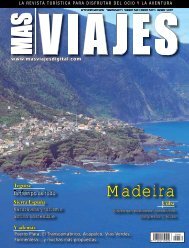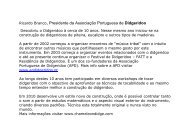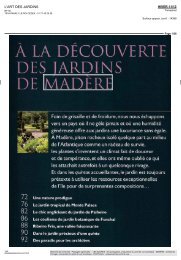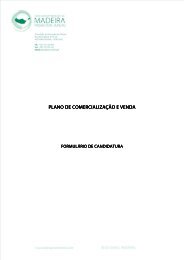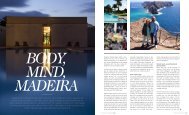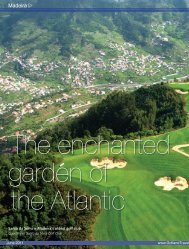Madeira Press Kit - Associação de Promoção da Madeira
Madeira Press Kit - Associação de Promoção da Madeira
Madeira Press Kit - Associação de Promoção da Madeira
You also want an ePaper? Increase the reach of your titles
YUMPU automatically turns print PDFs into web optimized ePapers that Google loves.
Between 1900 and 1919 the exportations ma<strong>de</strong> by Customs were high, showing the<br />
importance of this industry to <strong>Ma<strong>de</strong>ira</strong>. In 1906, there were, 30.000 outworkers in <strong>Ma<strong>de</strong>ira</strong>;<br />
in 1924, 45.000 and in 1950, 60.000.<br />
The First World War, between 1914 and 1918, brought serious problems to embroi<strong>de</strong>ry<br />
Industry. The German market closed, and in the United States the or<strong>de</strong>rs were reduced,<br />
what led to a <strong>de</strong>crease in the production and in the number of outworkers and embroi<strong>de</strong>ry<br />
houses. After the War, the production started to increase again.<br />
In 1923, there were in Funchal, about 100 embroi<strong>de</strong>ry houses, with exportations to the<br />
United States, England, South Africa, Cana<strong>da</strong>, France, etc.<br />
Influences:<br />
Influences:<br />
<strong>Ma<strong>de</strong>ira</strong> Embroi<strong>de</strong>ry, as it is known to<strong>da</strong>y, suffered influences not only from several<br />
countries such as England, France, Milan and German, but also from different periods such<br />
as the Renaissance, Rococo and Baroque. The result of this miscellany was the finest, the<br />
beauty and the perfection of these hand-ma<strong>de</strong> embroi<strong>de</strong>ry works which take many hours<br />
of work and <strong>de</strong>dication.<br />
To the different stitches was given a name, such as eyelets, garanitos (small relieves),<br />
rosettes, stars, viúvas and cavacas, richelieu stitch, etc.<br />
The The feature feature process:<br />
process:<br />
• The embroi<strong>de</strong>ry materials are imported as well as some of its <strong>de</strong>signs and<br />
some are ma<strong>de</strong> by stylists.<br />
• The <strong>de</strong>sign is transferred onto the tracing paper and pierced by a<br />
“picador”, a machine that makes tiny holes on the paper, along the traced<br />
lines of the <strong>de</strong>sign.<br />
• After, the tracing paper is put on the top of the cloth, ready to be stamped<br />
by a cloth soaked in blue dye. The <strong>de</strong>sign is in this way transferred to the<br />
material (linen, cotton or silk), and sent to embroi<strong>de</strong>reses.<br />
• When the outworkers finish it, they are sent back to the factory where the<br />
open work flowers and patterns are cut out.<br />
• It is then, washed and ironed, ready to carry a seal to prove it is genuine<br />
<strong>Ma<strong>de</strong>ira</strong> embroi<strong>de</strong>ry.




